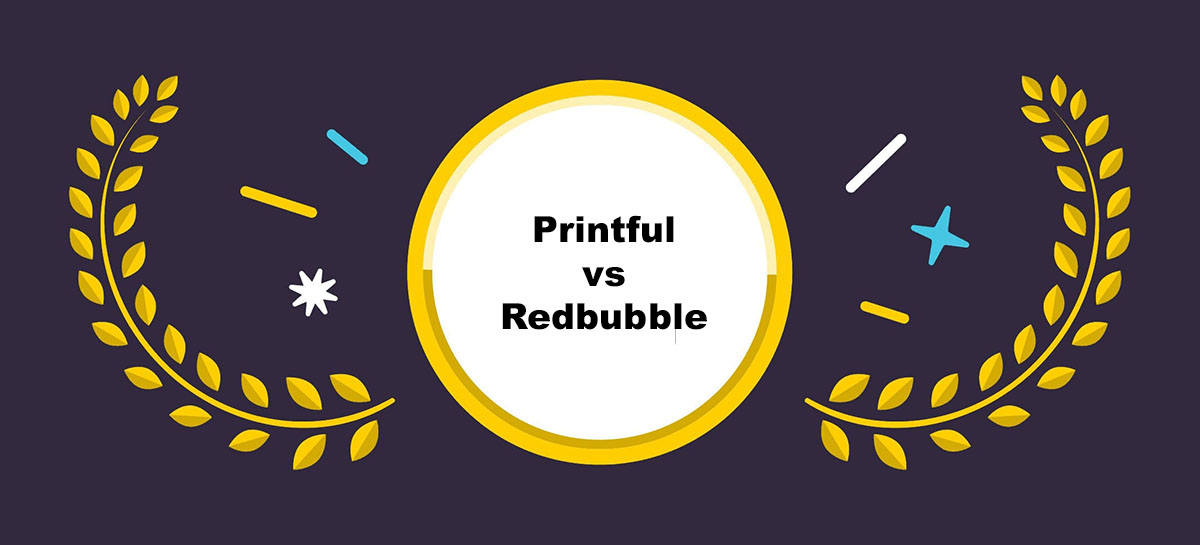Quick Verdict:
If you want to build a real brand, control your prices, and grow something scalable — Printful is the winner.
If you just want to upload art and see what happens — Redbubble is easier, but you’re capped.
I’ve Done POD for 10+ Years — Here’s the Real Deal on Redbuble vs Printful
I’ve used Printful. I’ve used Redbubble. And I’ve worked with clients who made six figures on both.
So yeah, I’ve seen how both platforms work when money’s on the line — not just in theory, but in real POD chaos: late shipments, viral orders, product returns, weird print quality issues — all of it.
This isn’t a fluff comparison. It’s what I’d tell a friend trying to start or scale their own POD brand.
Let’s get into it.
1. Business Model: Marketplace vs Full Control
Redbubble = Marketplace Model
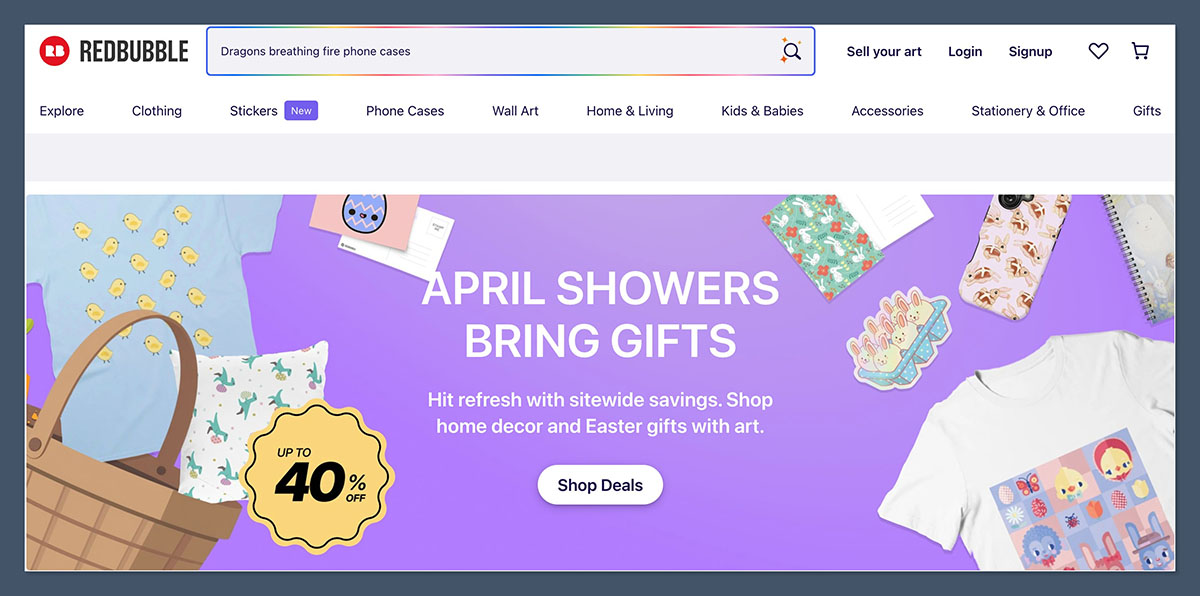
You upload a design → Redbubble lists it on their site → They handle everything else.
You don’t control pricing that much. You don’t own the customer data. You’re just another seller on their platform.
Pros:
- No setup work
- Built-in traffic from Redbubble’s audience
- No customer service or fulfilment headaches
Cons:
- No brand control
- You’re competing with thousands of other sellers
- Redbubble can ban your store or change policies at any time
Printful = White-Label Brand Builder
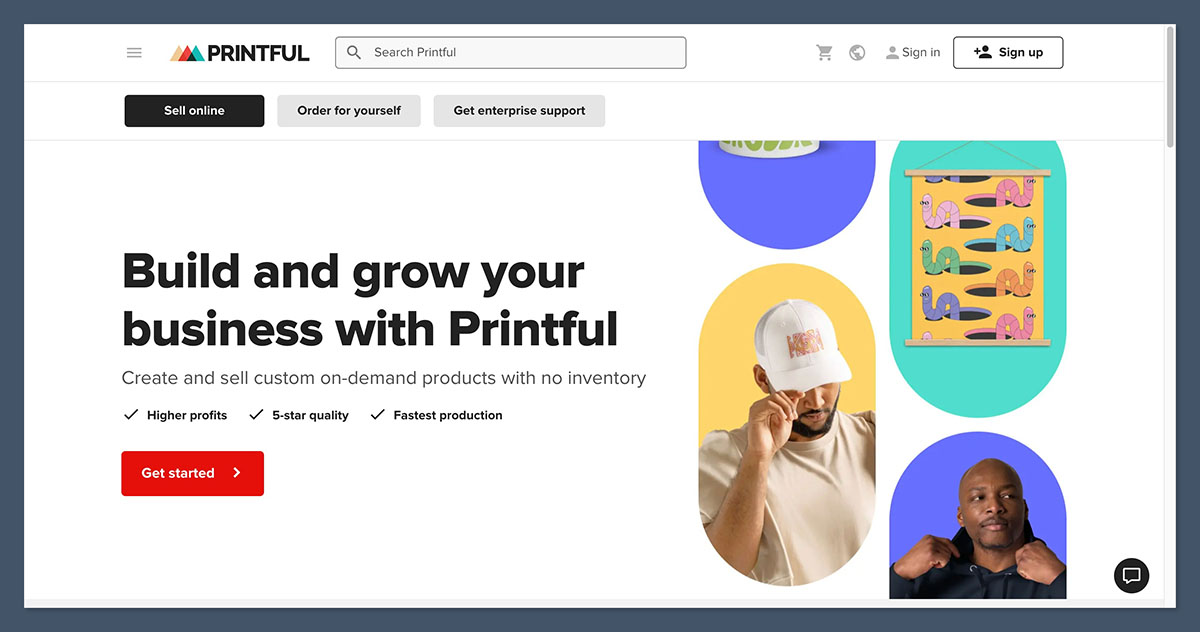
You create a store (Shopify, Woo, Etsy, etc.) → Connect Printful → Printful handles fulfilment + shipping
You own everything. Pricing, customer data, branding — it’s your business.
Pros:
- Full control of pricing, brand, products
- Integrates with top ecommerce platforms
- White-label everything (logo, packaging, domain)
Cons:
- You have to build your own traffic
- You’re responsible for customer service
Verdict:
If you’re serious about long-term business, Printful wins. If you just want to dabble, Redbubble’s easier to start.
2. Product Range and Customisation
Redbubble gives you access to around 70 product types. T-shirts, mugs, phone cases, posters, stickers — all the usual suspects.
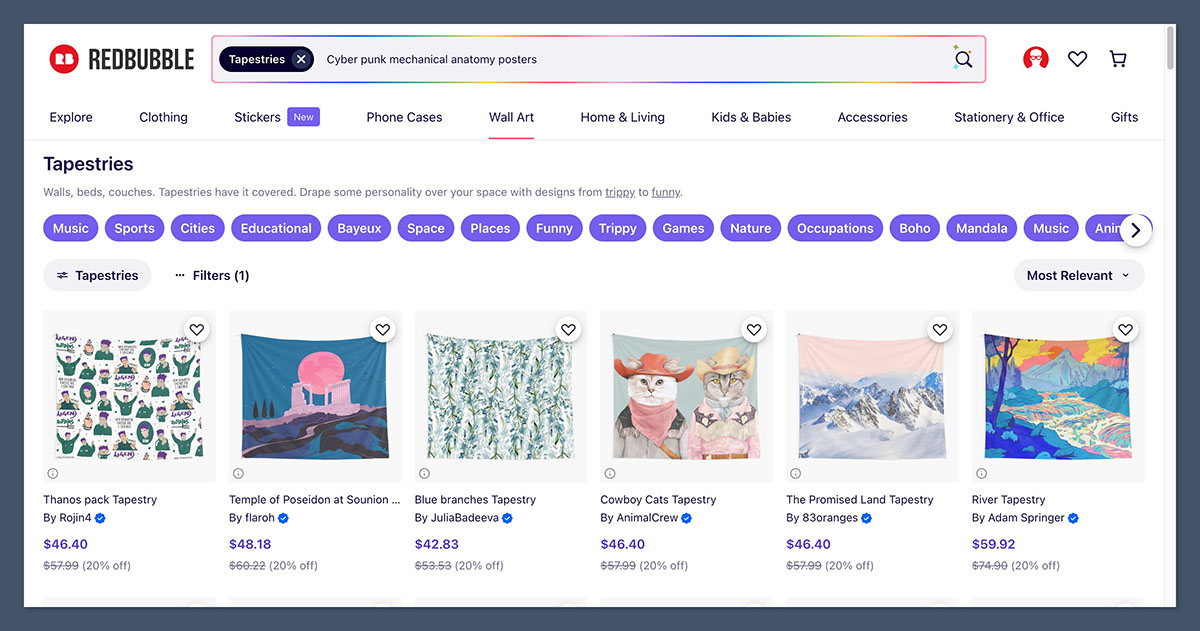
You upload a design once, and Redbubble automatically applies it across multiple products. It’s fast, convenient, and beginner-friendly.
But that’s where it ends. There’s no branding.
No way to customise the packaging. No control over print placement beyond the basic options.
Your product looks like every other item on Redbubble. It’s your art on a generic product, shipped in Redbubble’s name — not yours.
If you want to build a recognisable brand that stands out and feels premium, this won’t cut it.
Now here’s what you get with Printful:
Massive product catalog
Over 340+ products across categories — apparel, accessories, wall art, phone cases, swimwear, leggings, pet products, even shoes and bean bags. And it’s always growing.
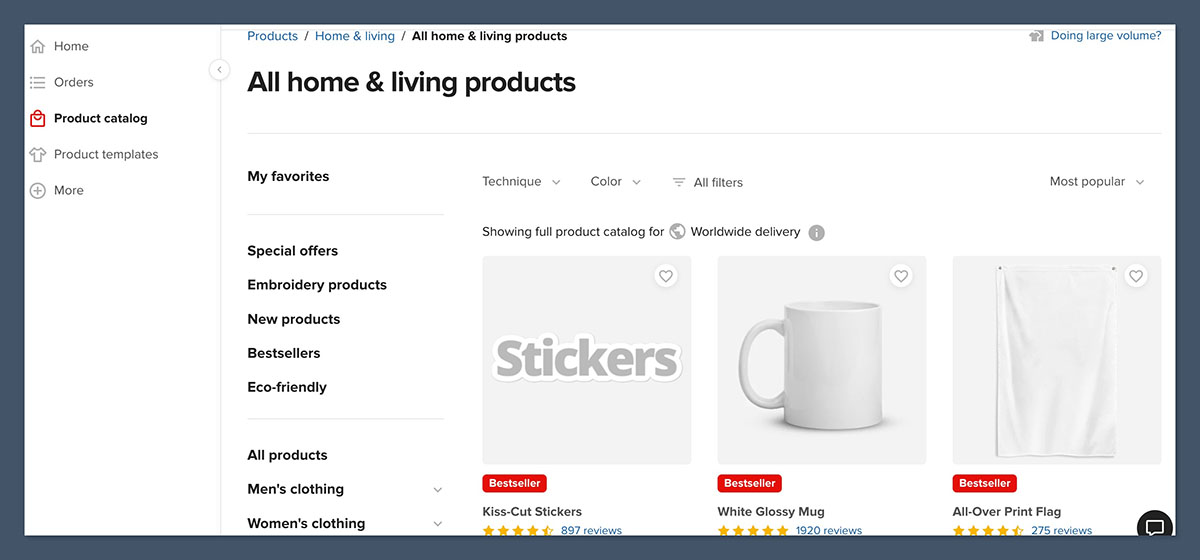
Real customisation options
You choose where the design goes: front, back, sleeves, inside or outside labels, packaging inserts. Want your logo on the sleeve and a quote on the back?
Easy.
Want an inside neck label with your brand name?
Done.
Multiple print methods
Printful supports:
- DTG (Direct to Garment) for sharp, full-colour prints
- Embroidery for a premium stitched finish
- All-over print (AOP) for seamless edge-to-edge graphics
- Sublimation, UV printing, and more
This gives you total freedom over how your product looks and feels — not just where the art goes.
Premium brands
You’re not limited to low-cost blanks. With Printful, you can offer your customers Bella+Canvas, Gildan, Champion, Adidas, Columbia, and more.
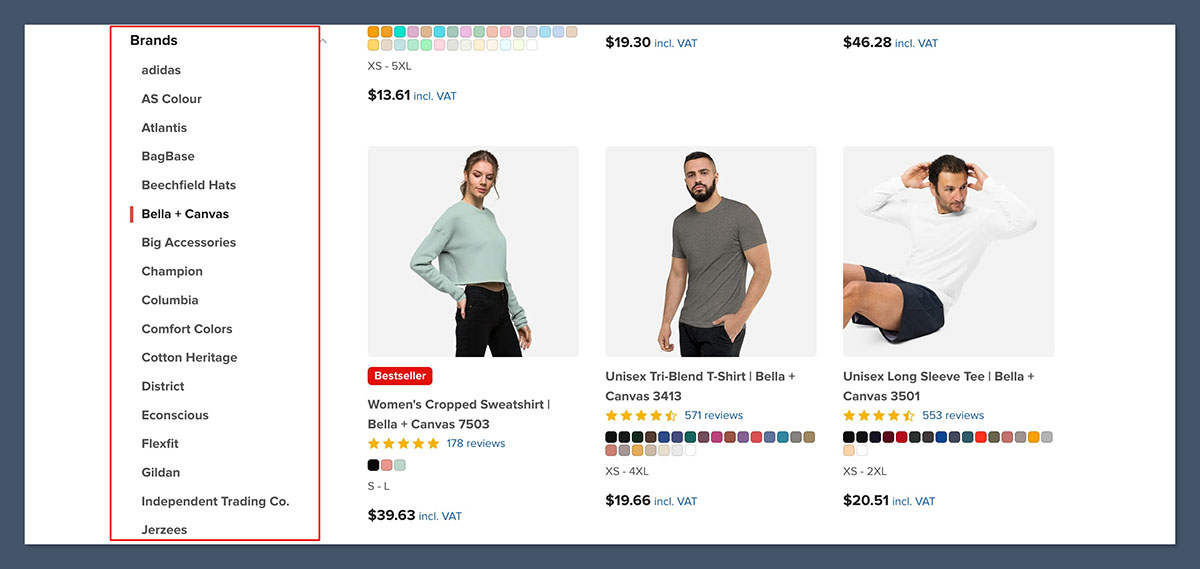
Perfect for targeting different price points or offering both budget and premium options.
Product bundling and variations
You can create collections, colour variants, sizing options — all through your ecommerce store setup. Redbubble doesn’t allow that level of merchandising control.
White-label fulfilment
Your customers won’t even know Printful exists. The packaging, invoice, and experience all look like it came directly from your brand.
And if you’re on the Growth Plan, you get access to more branded options like custom inserts, stickers, and packaging.
Verdict:
Redbubble’s product selection works if you just want to test designs.
But if brand, control, and quality matter to you — Printful is way ahead.
You’re not just uploading artwork. You’re creating a branded product line. And that’s a different game entirely.
3. Pricing Comparison: Printful vs Redbubble
Printful Pricing in 2025 (Updated)
If you’re confused about how Printful pricing works in 2025 — trust me, you’re not alone.
They’ve made a few changes over the last year, and while that’s caused some noise in the community, I actually think the current pricing model is the best it’s ever been.
The biggest shift?
They’ve simplified things — no more complex memberships or hidden upgrades. It’s straight-up clear now.
Here’s exactly how it breaks down:
Free Plan (Starter-Friendly)
- $0/month
- Pay only when you get an order
- Full access to:
- Product catalog
- Integrations (Shopify, Etsy, WooCommerce, TikTok Shop, etc.)
- Mockup generator
- AI design tools
- White-label packing slips
- 24/7 support
- Printful Academy content
You can literally build an entire POD business without paying anything upfront.
This is how most sellers start out — and honestly, it’s more than enough if you’re testing ideas or running a lean side hustle.
Growth Plan (For Scaling Up)
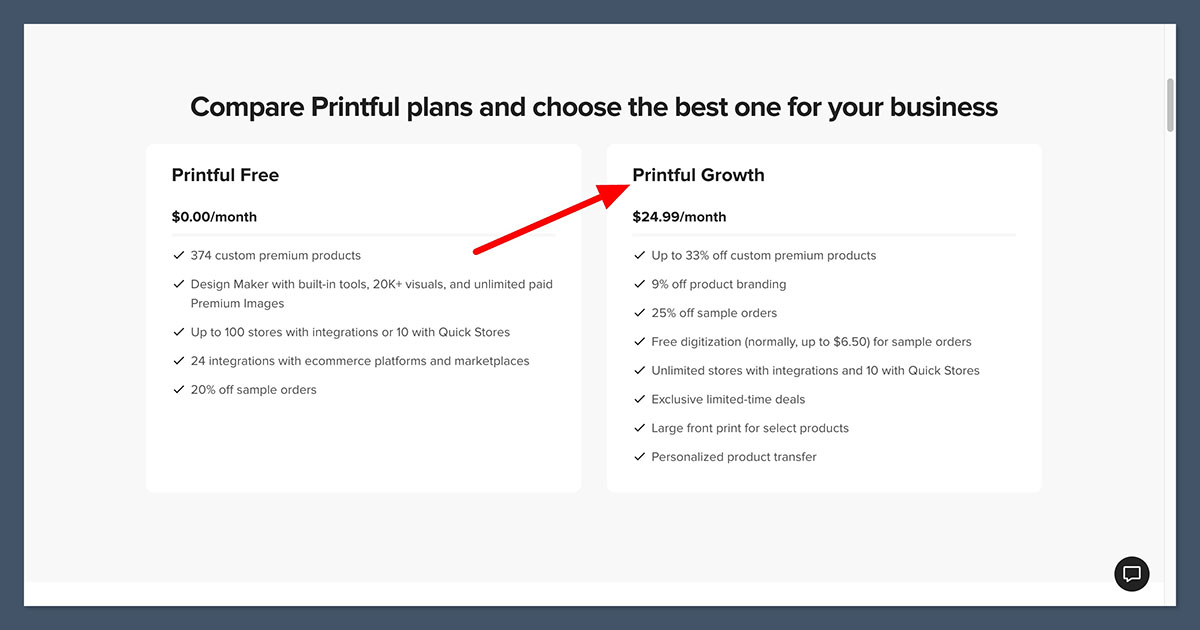
- $24.99/month
- Free if your store earns $12,000/year (just $1,000/month)
- Includes everything in the free plan, plus:
- Up to 33% off product base costs
- 25% off sample orders
- 9% off branding services
- Free embroidery digitisation (usually $6.50)
- Large front prints on selected products
- Unlimited stores
- Access to exclusive sales + limited-time deals
- Faster fulfilment priority for some items
- Free personalised product transfers
Let me be real — if you’re taking POD seriously and doing more than 30-50 orders/month, the Growth Plan pays for itself fast.
I run most of my stores on this plan, and by the time I hit $1k/month in revenue, I’m already saving more than I spend on the subscription.
Why I Rate Printful’s Pricing Higher Than Most POD Services
Here’s what I’ve learned after testing Printful, Printify, SPOD, Gooten, and CustomCat:
- Printful doesn’t charge monthly platform fees unless you want to upgrade
- There are no surprise fees when you’re checking out (some services add handling or fulfillment charges at the last step)
- Their shipping is predictable, easy to calculate, and doesn’t fluctuate randomly
- The branding options included with Growth are better than anyone else offers
- Product pricing is stable — you don’t get those weird spikes some platforms hit you with mid-season
And importantly:
As your business grows, your unit cost drops, without needing to negotiate or switch suppliers. It scales with you.
Real Product Cost Examples (US, 2025)
| Product | Base Cost | With Growth Plan |
|---|---|---|
| Gildan 5000 Tee | $6.95 | ~$5.50 |
| Gildan Hoodie (18500) | $22.25 | ~$17.00 |
| Bella + Canvas Tee | $10.50 | ~$8.20 |
| Embroidered Hat | $18.94 | ~$14.50 |
| Glossy Mug (11oz) | $6.50 | ~$5.00 |
That difference adds up fast when you’re running multiple orders a day.
Redbubble Pricing: How It Actually Works
Redbubble doesn’t charge you to list or sell. You make money by adding a markup on top of their fixed base price. The default is 20%, but you can change it.
Example:
If the base price of a shirt is $20 and you set a 20% margin, you make $4 per sale.
But here’s the catch:
You can’t control the base price, and Redbubble has been raising those regularly. If they increase it, your margin shrinks unless you manually adjust your markup.
What You Don’t Control:
- Shipping rates
- Packaging or branding
- The customer experience
- Discounts or loyalty perks
And small products like stickers? You might only earn $0.50–$1 per sale.
Verdict:
Redbubble is easy to start. No fees. No fulfilment work. But you’re capped. Low margins, no brand control, and no real way to scale.
If you want passive, hands-off income — fine. If you want real profits and control — Printful wins.
4. Profit Margins: Who Actually Pays You More?
Let’s be honest — this is what makes or breaks your POD business.
Margins determine if you’re running a hobby or a business. So how much do you actually make with each platform?
Redbubble: Small Cuts, Volume Game
With Redbubble, you’re earning a royalty, not true profit.
They set the base price. You can increase your markup percentage, but that’s the only lever you get.
Most creators leave it at the default 20% — because if you raise it too much, your retail price skyrockets, and your products stop selling.
Example:
- Redbubble hoodie base price: $39.99
- 20% margin = $8.00 payout
If Redbubble raises the base price to $42, you’re still stuck unless you manually adjust your markup — and even then, your control is limited.
It’s hard to build consistent margins, especially when you don’t control the price the customer sees.
Printful: You Set the Price, You Keep the Margin
With Printful, you’re the store owner. That means:
- You decide the retail price
- You know your product cost upfront
- You have full control over profit margins
- You can adjust for shipping, branding, and marketing
Example:
- Printful hoodie (Gildan 18500): $22.25 base
- Shipping: $8.49
- Your retail price: $44.99
- Your profit = $14.25 (before platform fees)
If you’re on the Growth Plan and get the hoodie at ~$17, your profit jumps to $19.25 on the same sale.
And unlike Redbubble, Printful lets you upsell, offer bundles, run discounts without eating your margins — because you’re in charge of pricing.
Margin Flexibility = Business Flexibility
Printful lets you:
- Price based on niche demand
- Test different pricing strategies
- Offer volume discounts
- Absorb shipping costs (or not)
- Raise prices during peak season
- Bundle with other products
- Adjust for ad spend and CAC (customer acquisition cost)
Redbubble? You get one knob to turn — the markup % — and hope it doesn’t kill your conversions.
Margin Comparison by Product
| Product | Printful Profit (Avg) | Redbubble Profit (Avg) |
|---|---|---|
| T-Shirt | $10–$15 | $2–$5 |
| Hoodie | $14–$20 | $6–$8 |
| Mug | $6–$10 | $1.50–$3 |
| Poster | $8–$12 | $2–$4 |
| Phone Case | $7–$11 | $2–$4 |
Assumes average retail price + standard shipping + no discounts
Final Thought:
Redbubble is fine if you’re chasing low-effort, low-margin sales and don’t mind earning $2–$6 per order.
But if you want real margins, real profit, and a business that scales — Printful gives you full control, and it shows in the numbers.
Verdict:
Printful smashes Redbubble when it comes to profit potential. If you’re serious about margins, it’s not even close.
5. Ease of Use
Redbubble: Set It and Forget It
Redbubble is about as easy as it gets. You upload a design, choose which products it goes on, and you’re live — all within minutes.
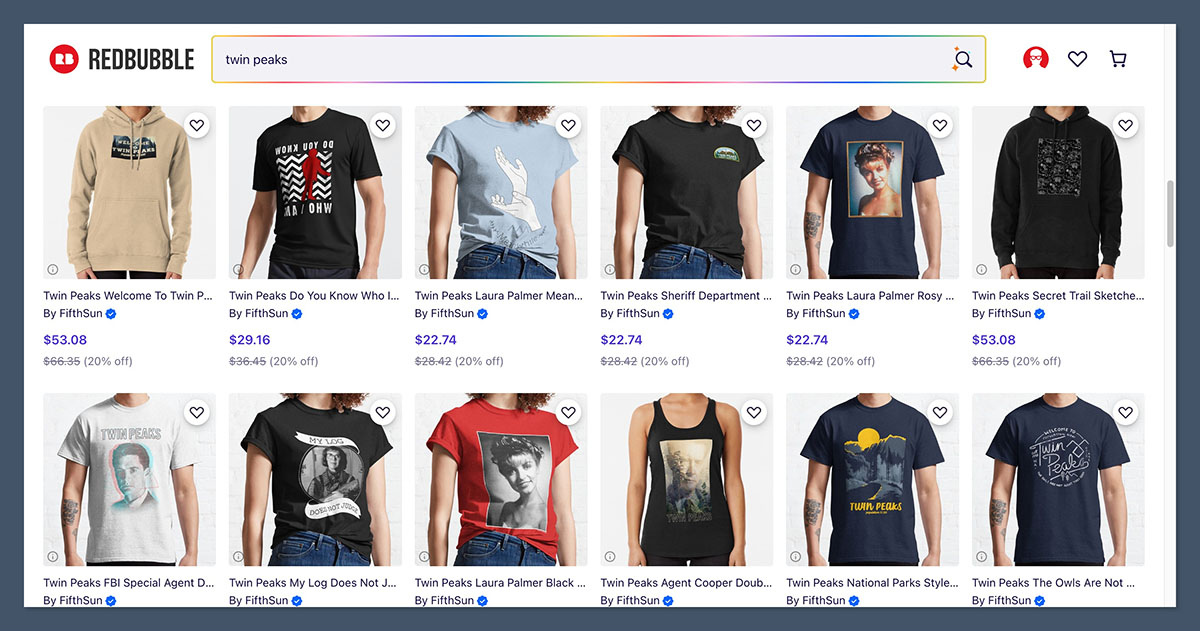
No store setup. No customer service. No marketing. The traffic either comes or it doesn’t.
For hobbyists, artists, or total beginners who want zero backend work, it’s perfect.
Printful: Real Business Setup
Printful takes more time upfront. You need to:
- Set up an ecommerce store (Shopify is best, but Etsy, WooCommerce, Wix all work)
- Connect it to Printful
- Build product listings with mockups and descriptions
- Handle your own marketing (SEO, social, email, ads)
But here’s the difference:
With Printful, you’re building a real business you control. You own the customer data. You build the brand. You’re not just a listing on someone else’s platform.
Verdict:
Redbubble = beginner easy. Printful = business owner ready.
6. Shipping + Fulfilment
Printful: Faster, Customisable, Global
Printful has fulfilment centres all over the world — US, EU, Australia, Canada, UK, Japan. Orders are printed and shipped from the location closest to the customer.
You get:
- Reliable tracking
- Faster delivery
- Branded packing slips
- The option to include custom inserts or packaging
- Backup fulfilment routes if one product is out of stock
US shipping examples:
- T-shirt: $4.69
- Hoodie: $8.49
- Mug: $6.49
It’s simple, transparent, and predictable.
Redbubble: No Control, Slower
Redbubble handles shipping completely, which sounds good — until you realise you can’t do much with it.
- No custom packaging
- No control over carriers
- No ability to offer upgraded or expedited options
- No way to track shipping speed promises
Customers often wait 7–21 days, especially internationally, and you can’t do anything to change that.
Verdict:
Printful is faster, more reliable, and way better if customer experience matters to your brand.
7. Store Design + SEO Potential
Redbubble: No SEO Control
Your Redbubble listings live on Redbubble.com, not your own site. That means:
- You don’t control the domain
- You can’t build backlinks to your own brand
- You can’t install analytics, run ads, or grow an email list
- You’re 100% dependent on their marketplace traffic
You get what you get — no optimisation, no strategy, no leverage.
Printful: Full SEO and Marketing Control
With Printful connected to Shopify (or similar), you can:
- Optimise each product for keywords
- Build backlinks
- Run paid traffic
- Set up landing pages, funnels, and retargeting
- Track performance with Google Analytics
- Build an email list to launch future designs to
Your site becomes your biggest marketing asset. Redbubble doesn’t even give you access to customer emails.
Verdict:
If traffic control, long-term growth, or SEO is important to you — Printful wins by miles.
8. Branding and Long-Term Growth
Here’s the real deal…
Redbubble: No Brand, No Loyalty
You can’t build a brand on Redbubble. No custom packaging. No customer list. No ability to upsell. You’re just one of thousands of sellers — and Redbubble is the brand the customer remembers, not you.
If Redbubble bans you tomorrow, your entire business is gone.
Printful: Total Brand Ownership
With Printful, you own everything:
- Branded packing slips with your logo
- Custom packaging (with inserts, stickers, thank-you cards)
- Upsells, cross-sells, email marketing
- Retargeting ads
- Repeat customer campaigns
- SMS or loyalty programs
This is how you build a long-term ecommerce brand that people remember and come back to.
Verdict:
Printful is made for real brand builders. Redbubble is made for passive dabblers.
9. Support + Seller Tools
Redbubble: You’re On Your Own
Support exists, but it’s slow.
There’s no seller dashboard with analytics worth anything. Most sellers rely on Reddit threads and trial-and-error.
Printful: Pro Tools + Real Support
Printful gives you:
- 24/7 live chat + email support
- A clean dashboard with profit breakdowns and product data
- Mockup generator
- AI design tools
- Keyword Scout for SEO
- Promo Maker for visuals
- Deep integrations with all major ecommerce platforms
- Discounted pro photo/design services if you want help
It’s not just a POD service — it’s a full backend team for your store.
Verdict:
If you’re trying to grow and need real tools — Printful is built for it. Redbubble just keeps things running.
10. Final Thoughts: Who Should Use What?
Here’s my straight-up advice:
Use Redbubble if:
- You want to test designs fast
- You’re not ready to build a store
- You want 100% hands-off selling
- You don’t care about margins or brand
Use Printful if:
- You want to own the customer relationship
- You care about packaging, branding, and margins
- You’re building something real — not just hoping for traffic
- You want control over pricing, SEO, and scaling
